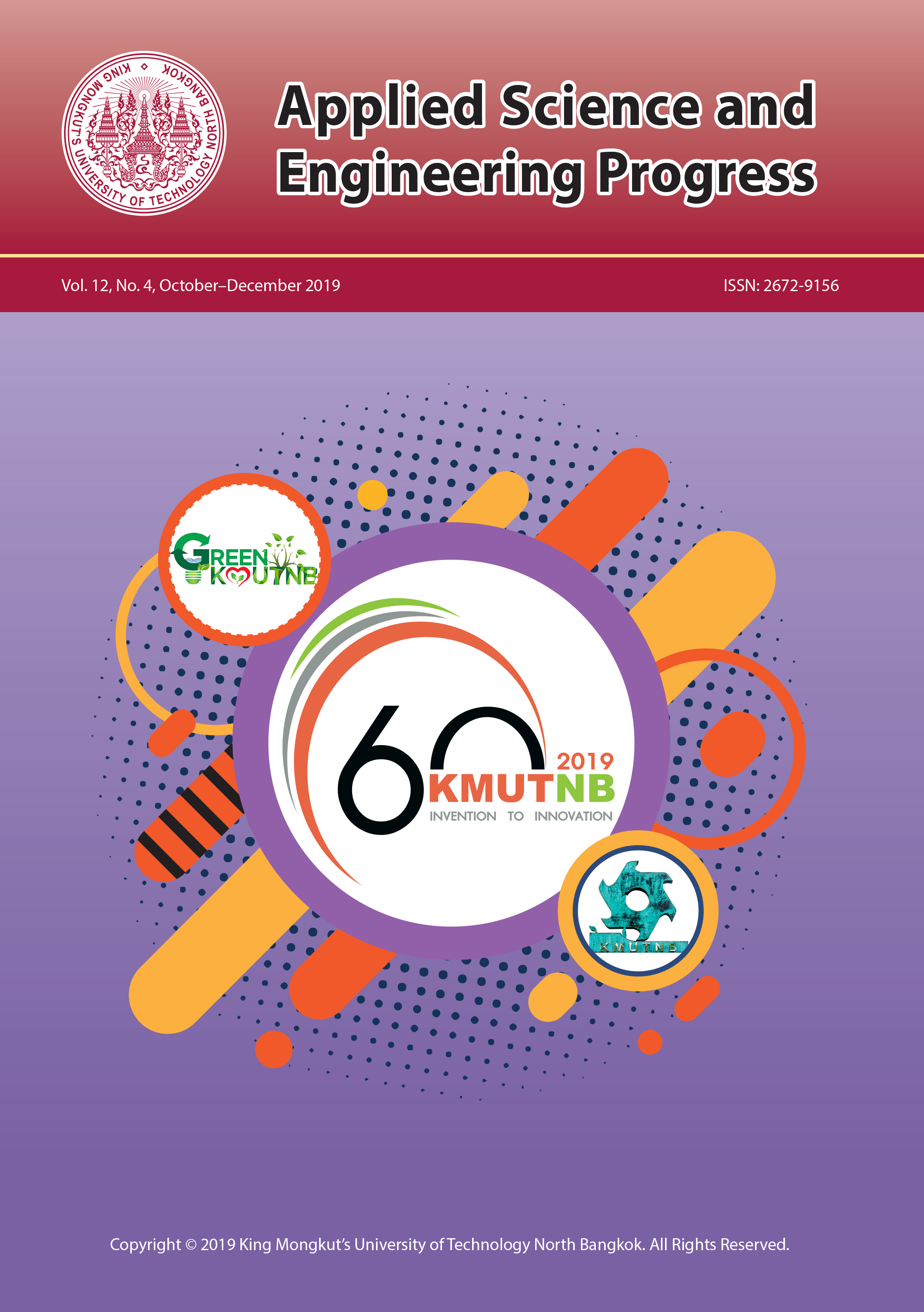Single Layer and Multilayers of Ru/Al2O3 Using Washcoating Method on Stainless Steel Substrate for Fischer Tropsch Synthesis in Microchannel Reactor
Main Article Content
Abstract
Major challenge of using metal based microchannel reactor is catalyst active phase deposition onto the metal surface. Washcoating method is one of the effective procedure for depositing supported catalyst onto the substrate surface. In order to control quality of the catalytic washcoated layer, stability of catalyst slurry, amount of catalyst solution and number of coatings were focused. The catalyst slurry used in this work contained 20wt% of 10%Ru/Al2O3, 5wt% of polyvinyl alcohol, 1% of acetic acid and water. The suitable pH of catalyst solution was in a range of 2–4. For the single layer coating, the good adherance of catalytic layer was observed. The highest %weight loss was 0.07% at pH value of 8. From the effect of catalyst slurry volume, 0.1 and 0.2 mL gave relatively low catlyst loading difference of before and after adhesion test. The average thickness of 0.2 mL single layer washcoating was 121.73 μm. Multilayer washcoating, the results clearly showed that the obtained washcoated layer can be used to apply onto the metallic substrate not only single layer but also multilayer. The double layer washcoating gave the highest catalyst loading per unit area for every volume of catalyst slurry. The 0.2 mL gave relatively good adherence and uniform washcoating layer in multilayer coating process. For single layer washcoat on microchannel structure, the obtained thickness was 5 μm.
Article Details
References
[2] S. A. Al-Sobhi and A. Elkamel, “Simulation and optimization of natural gas processing and production network consisting of LNG, GTL, and methanol facilities,” Journal of Natural Gas Science and Engineering, vol. 23, pp. 500–508, 2015.
[3] L. C. Almeida, O. Sanz, D. Merino, G. Arzamendi, L. M. Gandía, and M. Montes, “Kinetic analysis and microstructured reactors modeling for the Fischer–Tropsch synthesis over a Co–Re/Al2O3 catalyst,” Catalyst Today, vol. 215, pp. 103–111, 2013.
[4] M.-S. Shin, N. Park, M.-J. Park, J.-Y. Cheon, J. K. Kang, K.-W. Jun, and K.-S. Ha, “Modeling a channel-type reactor with a plate heat exchanger for cobalt-based Fischer–Tropsch synthesis,” Fuel Processing Technology, vol. 118, pp. 235–243, 2014.
[5] R. Myrstad, S. Eri, P. Pfeifer, E. Rytter, and A. Holmen, “Fischer–Tropsch synthesis in a microstructured reactor,” Catalyst Today, vol. 147, pp. S301–S304, 2009.
[6] I. Jung, K. S. Kshetrimayum, S. Park, J. Na, Y. Lee, J. An, S. Park, C.-J. Lee, and C Han, “Computational fluid dynamics based optimal design of guiding channel geometry in U-type coolant layer manifold of large-scale microchannel,” Industrial & Engineering Chemistry Research, vol. 55, pp. 505–515, 2015.
[7] Z. Ding, X. J. Hu, P. L. Yue, G. Q. Lu, and P. F. Greenfield, “Synthesis of anatase TiO2 supported on porous solids by chemical vapor deposition,” Catalyst Today, vol. 68, pp. 173–182, 2001.
[8] L. A. Truter, P. R. Makgwane, B. Zeelie, S. Roberts, W. Böhringer, and J. C. Q. Fletcher, “Washcoating of H-ZSM-5 zeolite onto steel microreactor plates – Filling the void space between zeolite crystallite agglomerates particles,” Chemical Engineering Journal, vol. 257, pp. 148– 158, 2014.
[9] L. Li, B. Xue, J. Chen, N. Guan, F. Zhang, D. Liu, and H. Feng, “Direct synthesis of zeolite coatings on cordierite supports by in situ hydrothermal method,” Apply Catalyst A: General, vol. 292, pp. 312–321, 2005.
[10] F. J. Echave, O. Sanz, and M. Montes, “Washcoating of microchannel reactors with PdZnO catalyst for methanol steam reforming,” Apply Catalyst A:General, vol. 474, pp. 159–167, 2013.
[11] G. Germani, A. Stefanescu, Y. Schuurman, and A. C. van Veen, “Preparation and characterization of porous alumina-based catalyst coatings in microchannels,” Chemical Engineering Science, vol. 62, pp. 5084–5091, 2007.
[12] L. C. Almeida, F. J. Echave, O. Sanz, M. A. Centeno, J. A. Odriozola, and M. Montes, “Washcoating of metallic monoliths and microchannel reactors,” Stududies in Surface Science and Catalysis, vol. 257, pp. 25–33, 2010.
[13] N. R. Peela, A. Mubayi, and D. Kunzru, “Washcoating of γ-alumina on stainless steel microchannels,” Catalyst Today, vol. 147, pp. S17–S23, 2009.
[14] L. C. Almeida, F. J. Echave, O. Sanz, M. A. Centeno, G. Arzamendi, L. M. Gandía, E. F. Sousa-Aguiar, J. A. Odriozola, and M. Montes, “Fischer–Tropsch synthesis in microchannels,” Chemical Engineering Journal, vol. 167, pp. 536– 544, 2011.
[15] A. Eleta, P. Navarro, L. Costa, and M. Montes, “Deposition of zeolitic coatings onto Fecralloy microchannels: Washcoating vs. in situ growing,” Microporous and Mesoporous Materials, vol. 123, pp. 113–122, 2009.
[16] A. Scheuer, W. Hauptmann, A. Drochner, J. Gieshoff, H. Vogel, and M. Votsmeier, “Dual layer automotive ammonia oxidation catalysts: Experiments and computer simulation,” Apply Catalyst B: Environmental, vol. 111–112 pp. 445–455, 2012.


